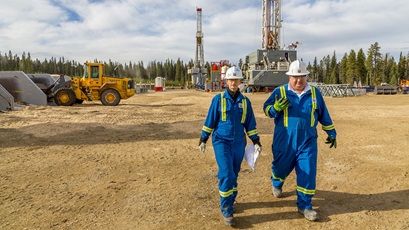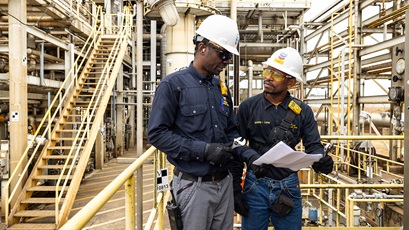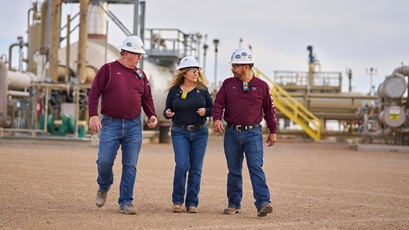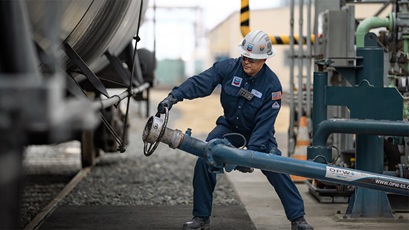our operations
marking a century of progress in Indonesia
3 min read | august 27, 2024
Chevron’s work in Indonesia began in 1924. That’s when the company dispatched a geological expedition to the island of Sumatra.
Six degrees of separation is the notion that we’re all six connections or fewer away from one another. But when it comes to Chevron Indonesia’s impact on the regions it works in, Wahyu Budiarto says the circle is even tighter.
“I always tell people that it’s three degrees of separation for the lives Chevron has touched or helped improve here,” said Budiarto, Chevron Indonesia’s country manager. “You can pick anyone, and I believe that will be the case.”
This theory is a testament to Chevron Indonesia’s work over the past 100 years.
wahyu budiarto
chevron Indonesia country manager
history lesson
In 1924, Chevron sent four geologists to Indonesia. This was Chevron’s first foray into the Eastern Hemisphere.
Twelve years later, Chevron secured exploration rights to an unpromising region on the island of Sumatra.
“It was a region that no oil company wanted,” the now-defunct Chevron World magazine reported in 1986. “A map drawn by a prominent government geologist in 1930 had noted that central Riau Province contained a large underground layer of granite, a clear sign that any search for hydrocarbons would be futile.”
To say that such a projection was inaccurate would be an understatement. Today, this region contains Duri Field, which was once among the largest oil and gas projects of its kind.

Chevron’s first crude reserve in the area was found under Duri Field in 1941. It comprised billions of barrels, and it was the largest deposit in Southeast Asia until the discovery of the reserve beneath Minas Field.

Chevron discovered Minas Field, the biggest oil reserve in Southeast Asia, on Dec. 4, 1944. It helped to make Indonesia a leading crude oil producer in the region.

Chevron, then CalTex Pacific Oil Company, carefully developed the giant Minas Field. This allowed the company to start production at 15,000 barrels of oil per day.
economic ripple effect
Chevron has produced more than 12 billion barrels of oil from Indonesia’s onshore and offshore fields.
And working with the Indonesian government and other partners, Chevron has helped create a positive economic ripple effect in the country. For example:
- The nation built the 2,700-kilometer (1,678-mile) Trans-Sumatra highway. It did so with support from government revenue generated by Chevron.
- From 2009 to 2013, each Chevron job supported an average of 36 other jobs in Indonesia.
in the community
Chevron Indonesia has been contributing to the economic and social well-being of residents since the 1950s. That was when it established the first local senior high school in Pekanbaru, Riau Province. Since then, the company has:
- Launched a business development program that led to more than 7,800 contracts with local Indonesian companies. The program also created nearly 52,000 jobs.
- Began working with YCAB Foundation. This organization helps end poverty through education and innovative financing.
- Built and sponsored Politeknik Caltex Riau, Riau Province’s first polytechnic university.
- Supported the Mangrove Ecosystem Restoration Alliance (MERA) program at the Muara Angke Wildlife Reserve in Jakarta.
- Built and sponsored the Politeknik Aceh school in response to the 2004 Indian Ocean earthquake and tsunami.
a new era
Chevron Indonesia stopped producing oil and gas in 2023. It’s now focused on supporting the growth of new energy.
For example, Chevron New Energies (CNE) is currently working with Pertamina, Indonesia’s largest energy company, in a geothermal exploration concession in Way Ratai, Lampung. CNE is also working with Pertamina to study the potential development of a CCS hub in East Kalimantan.
“To me, opportunities like this would not have been possible without the two factors we inherited from our 100 years of operation: our relationship and our reputation,” Budiarto said. “We have to be thankful to the people who are here and those who helped build our company along the way.”
topics covered
related content
-

 explainer: where do oil and gas come from?
explainer: where do oil and gas come from?our operationsdecember 30, 2024
-

 gas development opportunities in sub-saharan Africa
gas development opportunities in sub-saharan Africaour operationsdecember 20, 2024
-

 AI boosts profitability in the permian basin
AI boosts profitability in the permian basinour operationsdecember 18, 2024
-

 new california legislation misleading, chevron exec says
new california legislation misleading, chevron exec saysour operationsnovember 26, 2024
chevron email updates
Subscribe to our newsletter to receive news and updates.



